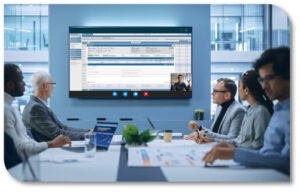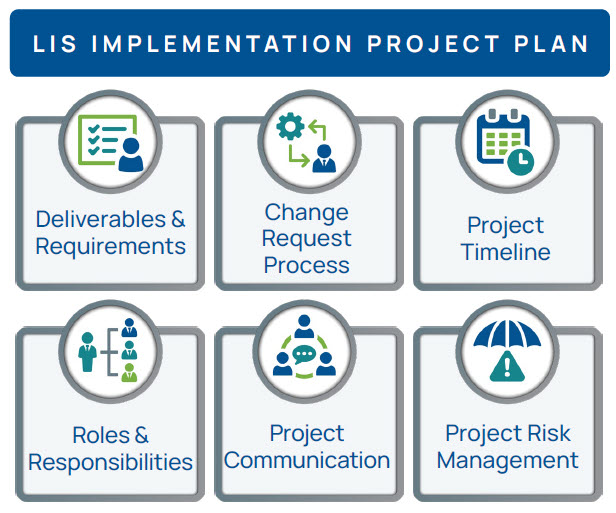Once there is a clear understanding of your lab’s setup and system requirements, discuss hardware and networking components or cloud-hosting requirements (e.g., servers, workstations, IP addresses, label printers, etc.). A cloud-hosted implementation tends to be faster than an on-premises deployment.
Next, discuss the details of building your database. Your vendor should walk you through this process, sharing with you everything they need to build your database. Thoroughly gathering and sharing this information will help your vendor perform a more comprehensive database build to get you started.
Lastly, define your integration implementation needs, specifically each interface with the LIS (e.g., demographics, orders and results, billing, reference lab, etc.). Provide your vendor with a comprehensive list of instruments
and workstations that will be connected to the LIS.
Training Phase
Every new system will require training, which may take several weeks to complete. You want to learn as much as you can about your new system to maximize its value and so that you can make changes without the vendor. Your new vendor should offer several training options so that you can select the type of training best suited for your lab. For maximum benefit, training should take place before, during, and after system implementation.
 Before Implementation
Before Implementation
If possible, coordinate the timing of training so that your LIS administrator(s) can participate in training class near the time of installation. This timing will allow you to have the knowledge to assist with the database build and system configuration. Most vendors currently offer online training for customers.
During Implementation
During implementation, the vendor may use a train-the-trainer approach. This allows key members of your staff to be thoroughly trained on the applications so that they can train additional current and future staff embers. The vendor should also offer guidance on best practices, go-live support, and other application guidance. You should become familiar enough with the application to make educated design/build decisions and to test the end-to-end workflow during systems integration testing.
After Go-live
Choose a vendor that offers options for ongoing training because there are likely to be changes to the software and changes in your laboratory’s staffing. Take advantage of any ongoing eLearning courses available for your new LIS.
Installation Phase
An expert vendor team should install all components of the new system and ensure that everything is working properly. During the installation process, all physical hardware and networking needs are set up in the customer lab as discussed in the planning phase. Once onsite, the vendor implementation specialists will test network connectivity and install the software and initial database.
System Hardware & Network
Setup and installation of the hardware and networking components is a key step. Hardware may include servers, workstations, and label printers and networking may refer to IP addresses and/or in wall wiring.
Development & Production Environments
If desired and agreed upon in the contract, a development or test environment can be deployed in addition to the production environment or live system.
Software
The vendor will install its software products with the agreed upon licenses per the signed purchase agreement. The timeline for the software installation will be established within the project plan and is dependent on having the hardware and networking components in place.
Database Build
Data for the database build, agreed upon in the planning phase, can now be used to build your new database, which will be the starting point for your new LIS.
Configuration Phase
Your vendor should work closely with you to build and configure interfaces, workflows, users, roles, and more. During this phase, the vendor’s interface team will configure and install the HL7 interfaces. The implementation team will perform system verification to confirm that the software is working as designed, configure instrument interfaces, and conduct onsite training.
System verification is a shared responsibility between vendor and customer. Ensuring that the applications have been set up properly and configured as described in the project plan is the vendor’s responsibility, while confirming the accuracy of individual data elements such as order choices, lab tests, fax numbers, and personnel information is the lab customer’s responsibility.
 Validation Phase
Validation Phase
Validation is key to ensure a successful transition to a live system. With guidance from your new vendor and project teams, you conduct validation of the newly installed system to ensure proper functionality. End users verify that all settings are configured correctly, and each component of the software is working as desired. Any final workflow or database setup changes are made at this time.
Validation is the responsibility of the lab, but the vendor can work closely with your facility to assist you with the process. The validation should include testing the integration between systems, result delivery accuracy for all reporting scenarios, and a training checklist for current and future employees. Lastly, validation should include integrated testing where the lab emulates test patients and sample flows in the LIS. Integrated testing validation should include ordering, resulting, result delivery and billing scenarios. This is done to verify that all aspects of the system are ready for production.
Go-live
Congratulations — you made it to the go-live! During go-live, the vendor should work alongside your team to ensure that the system is operating as intended. The vendor implementation team should be onsite during the scheduled go-live to assist with concerns and questions as they arise.
 Production Phase & Ongoing Support
Production Phase & Ongoing Support
After go-live, the vendor may assign a post-implementation customer care team to conduct regular check-ins to ensure that all your needs are being met and that as a new customer, you’re feeling comfortable using their system. As part of your LIS purchase, you should have selected a service and support plan that fits your lab’s needs. Savvy vendors should have multiple options to choose from depending on your lab’s needs. You should select a vendor that offers support 24/7/365, whose technical support center is located and staffed in the United States.
Also of consideration, find out if software upgrades are included as part of your support agreement. If not, you may want to consider another vendor, as updates can be expensive.
Keys to Successful Implementation
A new LIS is a very powerful and configurable tool that can be overwhelming for new users, which is why vendors need a developed, prescribed configuration process to help clients get up and running quickly and easily. Successful implementation requires a technical installation that is integrated within your environment and aligned to your business requirements. The implementation should include creation of a support environment to manage the application health, continuous optimization, and ongoing staff training.
 An LIS is a comprehensive system that requires a focused investment in time and effort to successfully learn, implement, and administer. Having a vendor that you can rely on, that provides ongoing training and resources and demonstrates leadership in and understanding of the laboratory market can be instrumental in guiding your success. Partnering with the right vendor can minimize risks and challenges that the project could face. Below is a list of lessons learned to enable the best possible implementation experience.
An LIS is a comprehensive system that requires a focused investment in time and effort to successfully learn, implement, and administer. Having a vendor that you can rely on, that provides ongoing training and resources and demonstrates leadership in and understanding of the laboratory market can be instrumental in guiding your success. Partnering with the right vendor can minimize risks and challenges that the project could face. Below is a list of lessons learned to enable the best possible implementation experience.
- A top factor for project success is strong, visible, and effective customer executive sponsorship and communication. The top reasons for user resistance are a lack of awareness about the change, comfort with the status quo, and fear of the unknown.
- Build time into the plan for staff to use the test environment to become familiar with the application.
- Establish a process for escalation and discuss it at project outset. Escalations should not carry a negative implication but should be viewed as a tool available to the project teams to improve the project’s outcome.
- Experience shows that a last-minute extension of the project duration does not result in a better outcome; it merely increases the project duration and cost.
- Standardization is a positive. If there is a best practice, establish and adopt it and help your users understand why it is important.
- Partner with a vendor that supports you well beyond go-live. End users should not fear that the level of change management and support will diminish once the vendor project teams are disbanded.
- Reserve project resources and energy for post-activation support and change stewardship.
Orchard Software’s Implementation Approach
At Orchard Software, we understand that each LIS implementation is different, and because of that we customize each installation to fit the needs of the lab customer, while still following our proprietary five-step implementation plan. Our process is an evolutionary methodology that was developed after many years of implementation experience. Our team of experienced Project Managers has collaborated to deploy all of Orchard’s solutions using the experiences that they acquired in the field.
 From the very beginning of the project, we use an approach based upon our experience with hundreds of laboratories. Since we are laboratory professionals, we offer precise setup and usage guidelines for the LIS that are backed by specific rationale. This entails making use of defaults, templates, and suggestions tailored to diverse types of laboratories (e.g., public health, physician office, reference lab, hospital, etc.). This strategy is crucial to ensure the system is configured accurately and effectively from the start, which results in a more dependable build, a shorter project timetable, and a system that is easier to troubleshoot and maintain.
From the very beginning of the project, we use an approach based upon our experience with hundreds of laboratories. Since we are laboratory professionals, we offer precise setup and usage guidelines for the LIS that are backed by specific rationale. This entails making use of defaults, templates, and suggestions tailored to diverse types of laboratories (e.g., public health, physician office, reference lab, hospital, etc.). This strategy is crucial to ensure the system is configured accurately and effectively from the start, which results in a more dependable build, a shorter project timetable, and a system that is easier to troubleshoot and maintain.
Black Book, a leading healthcare IT research firm, ranked Orchard as the #1 LIS vendor in 2023. This rating includes the top category scores for deployment, implementations, integrations, and interfaces.
About Orchard
Orchard Software Corporation is a leader in the LIS industry and offers a variety of laboratory system solutions. Orchard serves more than 2,000 laboratories across the country, helping them improve efficiency, reduce errors, and enhance integration. Orchard’s cloud-based solutions are installed in physician groups and clinics, hospitals, independent reference labs, student health centers, veterinary labs, public health organizations, universities, and retail facilities.
 Gathering Information
Gathering Information Narrowing the Search
Narrowing the Search

 Before Implementation
Before Implementation Validation Phase
Validation Phase Production Phase & Ongoing Support
Production Phase & Ongoing Support An LIS is a comprehensive system that requires a focused investment in time and effort to successfully learn, implement, and administer. Having a vendor that you can rely on, that provides ongoing training and resources and demonstrates leadership in and understanding of the laboratory market can be instrumental in guiding your success. Partnering with the right vendor can minimize risks and challenges that the project could face. Below is a list of lessons learned to enable the best possible implementation experience.
An LIS is a comprehensive system that requires a focused investment in time and effort to successfully learn, implement, and administer. Having a vendor that you can rely on, that provides ongoing training and resources and demonstrates leadership in and understanding of the laboratory market can be instrumental in guiding your success. Partnering with the right vendor can minimize risks and challenges that the project could face. Below is a list of lessons learned to enable the best possible implementation experience. From the very beginning of the project, we use an approach based upon our experience with hundreds of laboratories. Since we are laboratory professionals, we offer precise setup and usage guidelines for the LIS that are backed by specific rationale. This entails making use of defaults, templates, and suggestions tailored to diverse types of laboratories (e.g.,
From the very beginning of the project, we use an approach based upon our experience with hundreds of laboratories. Since we are laboratory professionals, we offer precise setup and usage guidelines for the LIS that are backed by specific rationale. This entails making use of defaults, templates, and suggestions tailored to diverse types of laboratories (e.g.,